Heather Lynn Robertson/Stoker writes a blog on marine invertebrates entitled Aristotle’s Lantern. As the title of her blog suggests, Heather seems to be particularly keen on sea urchins. In her own words, “Aristotle’s lantern… is a hard, calcareous feeding structure comprised of very intricate parts unique to sea urchins.”
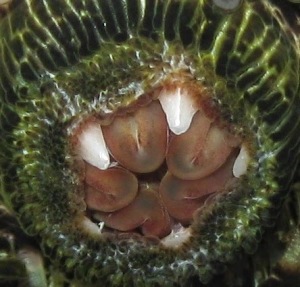
Here is a small excerpt from one of Heather’s recent blog posts:
“So this is the underside or oral surface of Spike, a purple urchin (Arbacia punctulata) that I had in a tank long ago. See his pretty purple-tipped spines? He was attached to the glass with his tube feet (those long tentacle-y looking things with round suction tips). The larger, striped tube feet with slightly indented suctions that surround the mouth are the buccal podia used for “tasting” stuff before chomping on it. The green fleshy part around the white pointy bits are essentially Spike’s “lips” or peristomial membrane (peri = around, stoma = mouth). The five soft, pinkish lobes in the center of the mouth are called paradental tongues (thank you Drs. Iain Wilkie, Michael Russell, and Joe Pawlik for helping me identify these structures!). The aforementioned “white pointy bits” are the five white “teeth” that Spike was using to scrape algae from the glass. These teeth are the protruding tips of the Aristotle’s lantern (the rest of the lantern is internal). The teeth and tongues work together to manipulate the food into pellet form before ingesting.”
This particular posting had started off as a competition, with readers being asked to identify the above image. I happened to be the first person to identify it has being an Aristotle’s lantern. My prize was supposed to be a photo and a shell but Heather suggested that it would be cheaper for her to email me the photo in jpeg format for me to print as many copies as I liked to share with my friends and she would also write 2 custom limericks of inverts of my choice for me. Having had Heather write a limerick for me before, I thought that this was a pretty good offer from her. I requested one limerick about cuttlefish and another about swimming anemone (that’s another story). She soon sent me the following two photos, rather than just one of, you guessed it, an Aristotle’s lantern: –
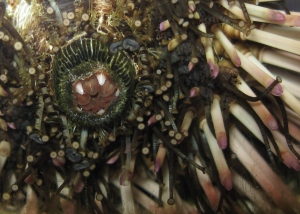
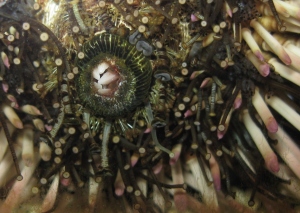
I later found both photos on Heather’s Facebook page, with the comments “Here’s the whole photo, mouth parts of a purple sea urchin I had in a tank long ago (“Spike”). So this is his underside,- he was scraping algae off the side of the tank with his “teeth”. Here’s a picture of him with “Porky” – “Spike” is on the right (long spines).”
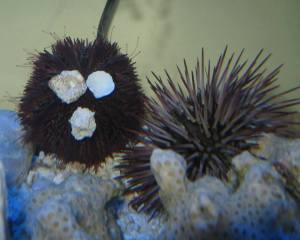
Porky is on the left, Spike is on the right (long spines)
Heather loves writing limericks about marine invertebrates. Here are two that she wrote recently about sponges:
Porifera
An animal? Completely ridiculous!
Just cells and sponge matrix quite spiculous.
No brain, heart, or gut!
No eyeballs! No butt!
Tis true though- the research? Meticulous!
Ode to “Red Arse”
It’s so boring it ain’t even funny.
Can’t eat it and it ain’t worth no money.
“So this sponge has no charm?
What could be the harm?”
It digs right through my oyster shells, Honey!
It’s now almost four years since Heather wrote my first limerick request as my prize in an earlier competition. Back then I asked for a limerick about barnacles. This is what she wrote for me at that time: –
Cirripedia
A barnacle’s a crustacean- who knew it?
Darwin did- but Linnaeus- he blew it.
What about its hard shell?
And no claws- what the hell?
It’s the nauplius larva that proved it!
The first of my new limericks to come through via the “Aristotle’s Lantern” blog was one about swimming anemone. This is the subject of another article. My second limerick came through on 3rd October, as follows: –
“Here is limerick number 2 that I promised Steve. He requested one about the cuttlefish and he mentioned to me lately that the giant Australian cuttlefish, Sepia apama, is being threatened by mining and shipping activities in Southern Australian. This is a real bummer as these are amazing animals and in my opinion, cuter than puppies.
So this limerick is in honor of the giant Australian cuttlefish, who have this very dramatic mating ritual where large males, flashing their chromatophores in fantastic light displays, fight and vie for the attention of females who float coyly by, accepting or rejecting offered sperm packets seemingly on a whim but really with great discretion. She’s very choosy about who’s sperm she wants to inseminate herself with (shouldn’t we all be?).
The small males can’t compete with the big bruisers so they have cleverly found a way to get their cuttlefish gametes into the genetic mix by morphing themselves into looking like females (they tuck their junk between their “legs”- just kidding- I don’t know how they do it exactly but you can find out by watching this excellent episode of NOVA called “Kings of Camouflage”.
Here’s the limerick!
Ode to the Giant Australian Cuttlefish
“Her” fin skirt looks sweet with its ruffle
as “she” glides by the big boys a-tussle.
This little male’s learned,
as he offers his sperm,
That the ladies like brains more than muscle.
All of the above mentioned limericks (and more) can be found in Heather’s collection of invertebrate limericks. A former limerick about cuttlefish reads: –
The cuttlefish flashed a “Good morning!”
Hectocotylus waving fair warning
Her tentacles grabbed at
His proffered sperm packet
Chromatophores blinking “I’m horny!”
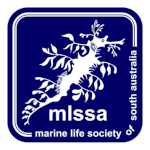
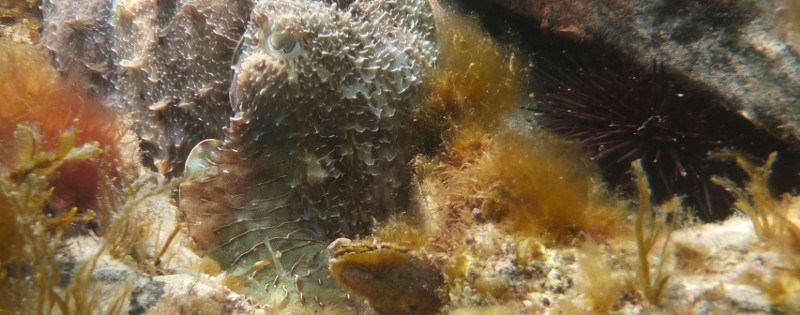
[…] to form, Heather then delivered on her promise to me of a limerick about the swimming […]
The teeth and tongues work together to manipulate the food into pellet form before ingesting
Thanks for these details, Tyra